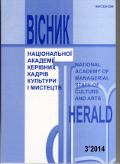INTERACTIVITY AS THE MAIN FEATURE OF CONTEMPORARY NETWORK ART CYBERCULTURE
DOI:
https://doi.org/10.32461/2226-3209.3.2014.138109Keywords:
art, interactivity, virtual reality, cyberculture, recipientAbstract
Important in the context of studies of modern innovations in the arts seems protovirtual analysis of reality, which include all forms and elements of virtuality that occur naturally or deliberately created by artists from or with the use of modern electronic technology. The main feature of art protovirtual reality is interactivity.
For protovirtual reality characterized by the inclusion of computer special effects, computer graphics into the fabric of traditional artistic works of art. The major features of contemporary art shaped by technology is interactive,
involving: – the possibility for the viewer to contact the artist and even participate actively in his work; – Creation of new artistic means; – Digital elite (often network and media) art.
Interactivity as a way to actively influence the recipient in virtual reality mode specific time of its formation and
perception makes it possible to "combine artistic image that traditionally formed in the psyche of the subject, with more or less active influence on one art object that transforms its material and thus corrects and artistic image. Speaking of interactivity as the most important characteristic of virtual reality, which implies an active bidirectional interaction with the built environment, it is worth noting that this feature distinguishes it from most traditional genres of art, which to some extent also a specific technology creation and broadcast of illusory worlds. The trend towards interactivity is particularly noticeable in contemporary art, in which simplicity of execution, intentional departure from skill (skill in the traditional sense) suggests the richness of meaning by the viewer or listener, as this trend is typical for modern improvised music, and contemporary visual art.
The so-called interactive art has no single, clear-cut beginning of its appearance.
Proponents of interactive art tend to think of innovative multimedia conversion as a new cyber-culture that could
give rise to a completely new form of art in which an infinite number of recipients will be able to participate as equals in the creation of works of art.
So it's safe to say that interactivity is now becoming the most important and typical feature of postmodern culture. Today interactive is any kind of multimedia creation, in which recipients or undefined number of users are able to
participate actively in the process of artistic creation and in its sole discretion to alter the pace of the process and the final version of the proposed product.
It is noted that the art network are no longer restricted to interactive online projects, it turns into reality, creating
networks that connect people, create new horizontal communication – from person to person, avoiding propaganda
machine media.
In general, the use of digital computer technology determined the change of epochs in art, which has become one of the most interactive-oriented by its history. The characteristic features of the new era, given the above, will further
the mutual integration of different kinds of art, and art and advanced scientific achievements, as well as the development of multisensor arts and art variable reality.
Downloads
Published
Issue
Section
License
Authors who publish with this journal agree to the following terms:
1. Authors retain copyright and grant the journal right of first publication with the work simultaneously licensed under a Creative Commons Attribution License International CC-BY that allows others to share the work with an acknowledgement of the work's authorship and initial publication in this journal.
2. Authors are able to enter into separate, additional contractual arrangements for the non-exclusive distribution of the journal's published version of the work (e.g., post it to an institutional repository or publish it in a book), with an acknowledgement of its initial publication in this journal.
3. Authors are permitted and encouraged to post their work online (e.g., in institutional repositories or on their website) prior to and during the submission process, as it can lead to productive exchanges, as well as earlier and greater citation of published work (See The Effect of Open Access).


